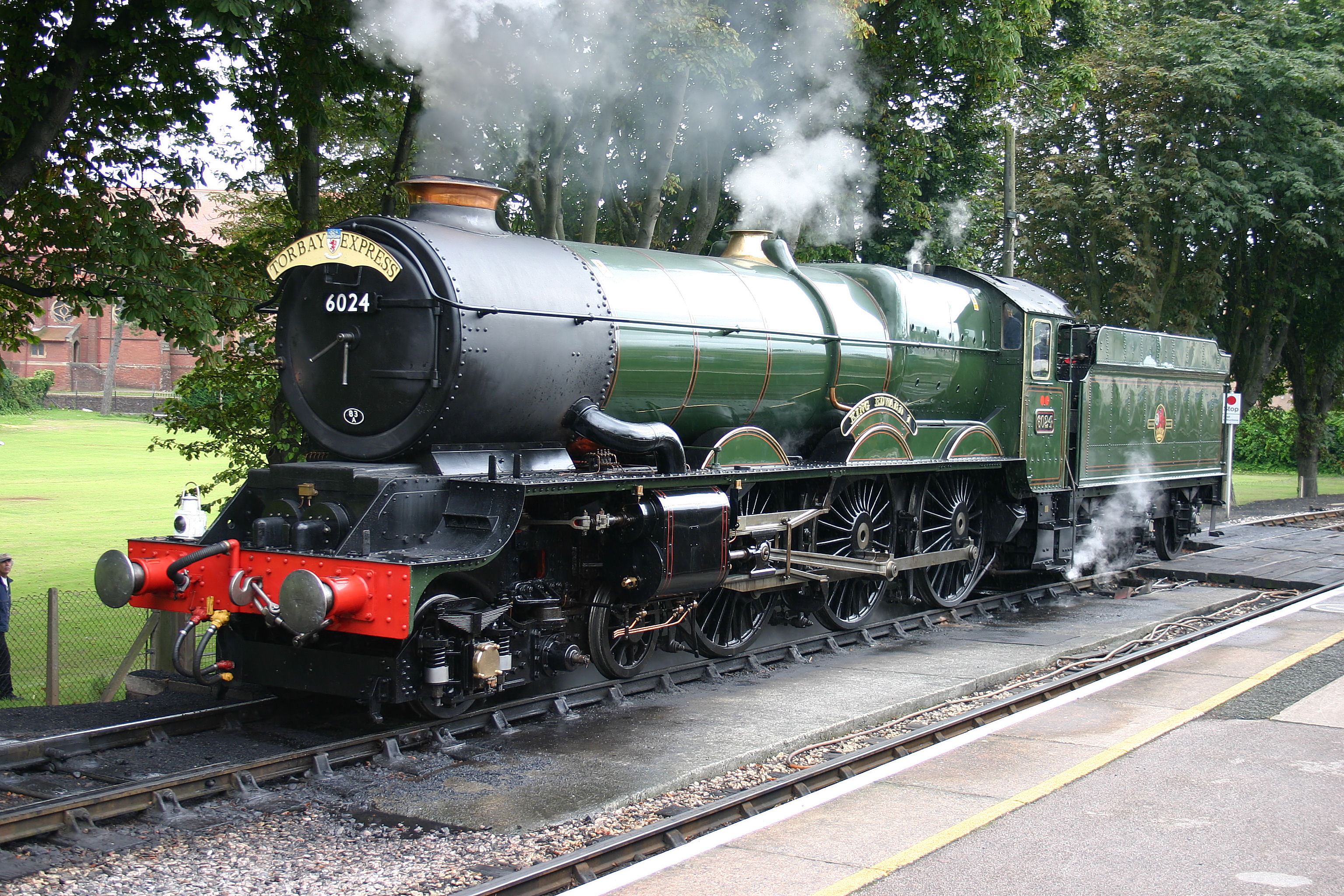- GWR 6000 Class
Infobox Locomotive
name=6000 "King"-class
powertype=Steam

designer=Charles Collett
builddate=1927-1930
whytetype=4-6-0
cylindercount=4
gauge=Standard gauge
leadingsize=3ft
driversize=6 ft 6 in
length=68 ft 2 in
weight=135tons 14 cwt
fueltype=Coal
fuelc
watercgallon s
boiler=6ft-5ft 6½in x 16 ft
boilerpressure=250 lbf/in²
tractive effort=40,300 lbs
tubearea=2,008 ft²
fireboxarea=194 ft²
superheaterarea=313 ft²
cylindercount=Four
cylindersize=16¼ x 28 in
railroadclass=6000 "King"-class
numinclass=30
roadnumber=6000-6029
officialname="King"-class
locale=Great Western Railway /Western RegionThe
Great Western Railway 6000 Class or King is a class of4-6-0 steam locomotive designed for express passenger work. They were the largest locomotives the GWR built. They were named after kings of England, beginning with the reigning monarch, King George V, and going back through history (but with the final pair of engines later renamed after George V's eldest sons, who succeeded him).Overview
This class was designed under the direction of C. B. Collett, partly as a response to the
Great Western Railway 's publicity department, in order to regain the 'most powerful express passenger steam locomotive in Britain' title, which had been taken from Collett's Castle Class in 1926 by the Southern Railway Lord Nelson Class. The engines, as originally designed, delivered convert|39700|lbf|abbr=ontractive effort , with 16" bore x 28" stroke cylinders and 250 psi boiler. At a request from Sir Felix Pole, the Great Western's General Manager, to get the tractive effort up to above 40,000 lbf (a major goalpost), the cylinders were enlarged to 16.25" bore, bringing the figure up to convert|40300|lbf|abbr=on. This increase was removed on all members of the class at their first major overhaul. The distinctive design of the leadingbogie (with outside bearings on the fore wheel and inside bearings on the rear wheel) was to allow these larger cylinders.The first, 6000 "King George V", appeared in 1927 and was sent on a tour of North America, for the Centenary celebrations of the
Baltimore and Ohio Railroad (B&O), where its sleek appearance and smooth performance impressed all who witnessed it, the application of pressurised oil lubrication showed its advantages over the largely grease lubricated American Locomotives, and was even incorporated into a later design for the B&O in 1928. 6000 "King George V" was presented with a brass bell to mark the occasion. An original naming scheme planned for the Kings was to name them after cathedrals, but when the trip was planned, an unmistakably British icon was needed. During planning and construction, the engine was dubbed the 'Super-Castle'.They were engines to be reckoned with, powering the Western Region's crack expresses like the Cornish Riviera Limited up until the end of regular steam hauled express services on the WR.
An interesting fact is that although the railway claimed that the class was built in response to longer and heavier trains, it was several years after the introduction of the class before the platforms at the company's major stations were lengthened to accommodate these trains. The class was restricted to the London-Taunton-Plymouth and London-Birmingham-Wolverhampton main lines, and even then, only after bridge strengthening had taken place, due to the engines' large boilers giving them an axle weight of a massive 22.5 tons.
William Stanier based hisLMS Princess Royal Class design on the King Class, but with an enlarged boiler and firebox necessitating a 4-6-2 wheel arrangement.In 1947, experiments had been made with a four-row high-degree superheater in 6022 King Edward III, owing to a decline in the availability of high-calorific South Wales steam coal on which the GWR had always relied for its locomotive performance. During the 1948 locomotive exchanges, King Henry VI had performed disappointingly using Yorkshire coal, despite demonstrating the 4-6-0 type's unique sure-footedness when climbing out of King's Cross, where Pacific types were apt to slip alarmingly. After this, four-row superheaters were fitted to the class, and modifications were also made to the draughting arrangement, using 6001 King Edward VII as a test-bed. From September 1955 double blast-pipes and chimneys were fitted, initially to 6015 King Richard III. The whole of the class was then modified to encompass the improvements that had been trialled on these various locomotives. As a result, their final years in British Railways ownership saw the very best of their performances, particularly on the fearsome South Devon banks at Dainton, Rattery and Hemerdon.
They were all withdrawn by 1962, replaced by less powerful but more widely available
diesel-hydraulic s.Loco specification
List of King Class locomotives
Preservation
Three, 6000 "King George V", 6023 "King Edward II" and 6024 "King Edward I" have been preserved.Gallery
Audio files
External links
* [http://www.greatwestern.org.uk/m_in_kin.htm Great Western Society pages on King Class]
* [http://www.didcotrailwaycentre.org.uk/great_western_society/6023_king_edward_11.shtml King Edward II]
* [http://www.6024.com/home.htm 6024 Preservation Society Ltd]
Wikimedia Foundation. 2010.


